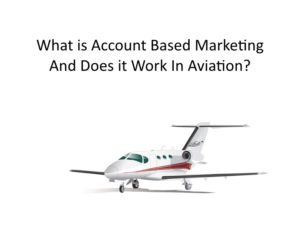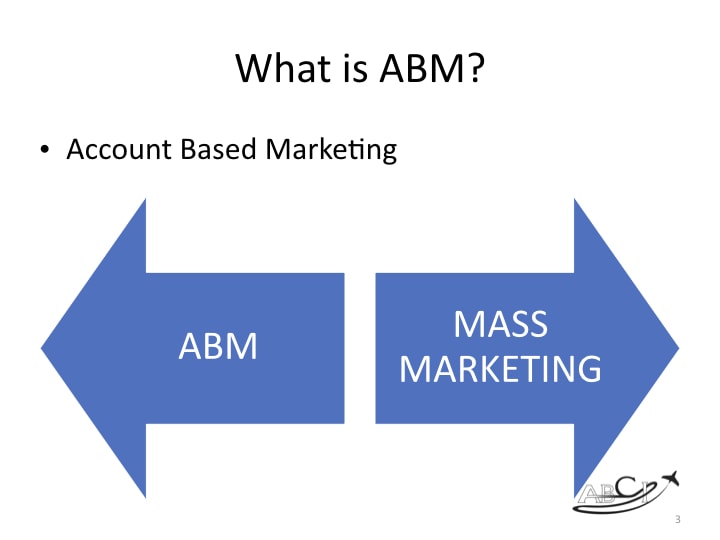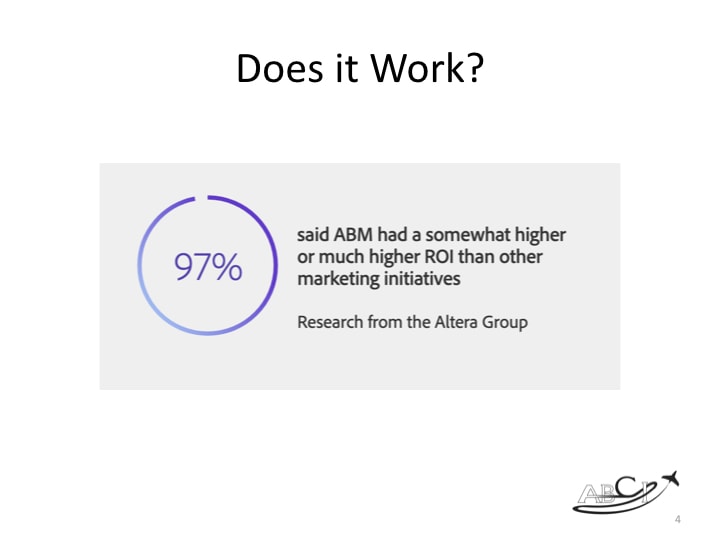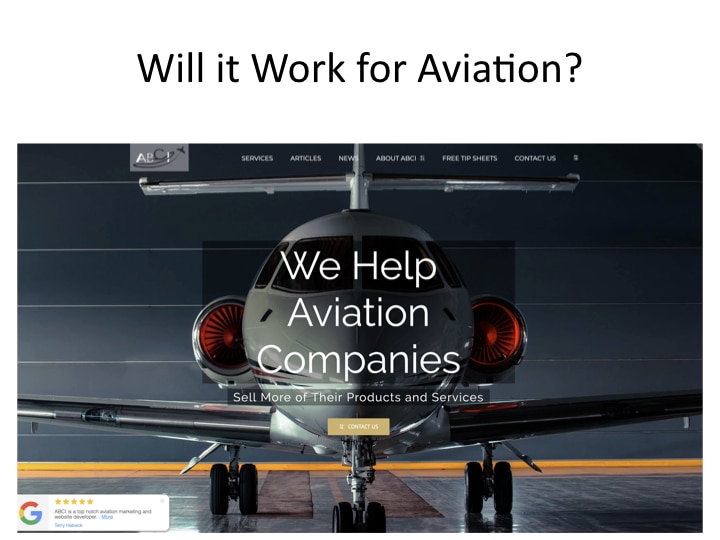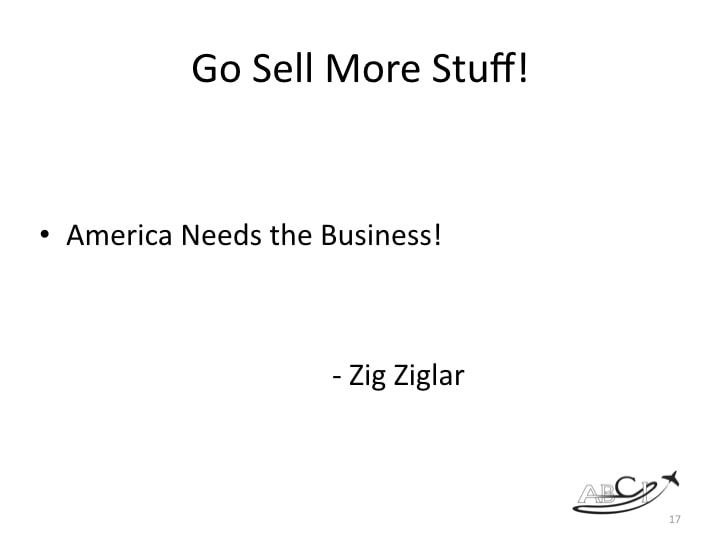“What do you think of ABM for aviation marketing?” When you’re a doctor, people at cocktail parties ask you about a pain in their knee. When you’re a marketing consultant, they ask you about the latest new cool aviation marketing solutions, tools, trends or methodologies.
You’ve heard the buzzword, and the promises –
97% of respondents said ABM had a somewhat higher ROI than other marketing initiatives” (the Altera Group)
We found that marketing and sales teams that take an ABM approach together — and spend time maturing their processes and practices around it — can be as many as 6 percentage points more likely to exceed their revenue goals than teams less ABM-advanced. – (Forrester Research)
But there are many sales and marketing trends and techniques that tend not to work in the highly-specific, long-cycle aviation market.
Is ABM a good strategy for an aviation company? And how can you use it for best results? John and I discuss this in our latest podcast.
[embedyt] https://www.youtube.com/watch?v=7MEs_85FHWU[/embedyt]
[smart_track_player url=”http://traffic.libsyn.com/aviationmarketing/What_is_ABM_and_Will_It_Work_for_Aviation_Marketing_.mp3″ background=”default” ]
Paula Williams: Welcome to this week’s episode. What is account based marketing and does it work in aviation?
John Williams: That’s a heck of a good question.
Paula Williams: I’m Paula Williams.
John Williams: Actually, there’s two questions.
Paula Williams: Right?
John Williams: I’m John Williams.
Paula Williams: We are ABCI. ABCI’s mission is-
John Williams: To help you ladies and gentlemen out there in the aviation world sell more products and services.
Paula Williams: Absolutely. ABM is all the rage these days. This is actually John’s idea, this episode, right?
John Williams: I beg your pardon. I just brought the topic up.
Paula Williams: Exactly. And said, “We should probably be talking about this, and what it means and everything else.” What is it and will it work in aviation? Right?
John Williams: Mm-hmm (affirmative).
Brought to you by our Aviation Sales and Marketing Lab
Paula Williams: Okay. This episode is brought to you by our Aviation Sales and Marketing Lab. If you join by January 31st of 2020… Happy new year, by the way.
John Williams: Yeah.
Paula Williams: You will be included in our Aviation Sales Basics Course, which is just getting started this month. We start a new course a couple times a year, just to make sure that we’ve got some people starting at the same time, and we’re able to accommodate some folks in the industry who are maybe getting into sales for the first time from somewhere else.
John Williams: Sales in aviation.
Paula Williams: Right, exactly. Coming from a different field than aviation or coming from aviation but had never done sales before, either way.
John Williams: Or they don’t realize they haven’t done sales. But if you’re in any profession, you are doing sales every day you walked into the worksite, be it the cockpit, or the job, or whatever.
Paula Williams: Absolutely.
John Williams: You’re selling something.
Paula Williams: Right. Selling something to your passengers, or your boss, or your-
John Williams: ATC.
Paula Williams: ATC. Or your kids or somebody. Chances are you’re doing sales of some kind because you’re trying to persuade somebody of something, and you’re probably pretty good at it if you just think about it, right?
John Williams: Mm-hmm (affirmative).
Paula Williams: Okay. This is our online course and coaching. It’s included in our Sales and Marketing Lab, which is our tools, skills, and networking system that is really put together to help people in aviation become successful in the least expensive way possible, right?
John Williams: Mm-hmm (affirmative).
What is ABM?
Paula Williams: Okay, cool. All right, so what the heck is ABM?
John Williams: Well, the words are account based marketing.
Paula Williams: Exactly.
John Williams: Now.
Paula Williams: Mm-hmm (affirmative). It’s funny how… A lot of times they will take a concept that is a thousand years old or longer, could be probably more like 6,000 years old.
John Williams: In some cases.
Paula Williams: As long as people have been roaming the earth, and they will make a new word for something that people have been doing for a really long time.
John Williams: True.
New term for an old marketing strategy
Paula Williams: Account based marketing is really something along those lines. People have been doing it for a really long time in business-to-business sales and other things. It’s just that they haven’t called it account based marketing or ABM.
This is kind of a new term that’s making the rounds in the business magazines and other places, and so we thought we would kind of define it and show where it fits in the concept of all of the possible ways of doing sales, and how it fits with what we do and what we teach, right?
John Williams: Uh-huh (affirmative).
Paula Williams: Okay. Basically, if you put one-to-one sales on one side and mass marketing on the other side of a continuum, ABM is closer to the left. Closer to the first side that we mentioned. Is closer to the one-to-one sales that we talked about.
John Williams: True.
Paula Williams: Basically, you’re defining an account, and you’re thinking just about that person. How do we personalize this and make it really super specific to this one client or this one prospect? It’s kind of a reaction, I think, to a lot of the automation that’s been going on over the last 10 years. Everybody is trying to sell everything to everybody, and you’re getting completely irrelevant stuff in your inbox and everywhere else, right?
John Williams: I mean, I’m getting ready to block some accounts from known industries that are sending me emails four times a day trying to sell their crap.
Paula Williams: Right. And it’s not very personalized and not very specific.
John Williams: No.
Paula Williams: And people are calling you on the phone saying that your computer’s extended warranty is about to expire. They have no idea even if you have a computer, much less if it has an extended warranty that’s about to expire, right?
John Williams: Yeah. I’ve got a car that’s almost an antique now. They’re talking about my warranty’s about to expire. You think?
Paula Williams: Right. They’re basically playing the odds and playing a numbers game. That’s the mass marketing side of the spectrum. ABM is really on the other side of the spectrum. In aviation, we like it a whole lot better, right?
John Williams: Of course.
Does ABM Work?
Paula Williams: Okay. Does it work? This is from the Altera Group. 97% said ABM had a somewhat higher or much higher ROI than other marketing initiatives. The reason is because you can really devote your resources, your time, and energy, and money toward a smaller group.
Paula Williams: What we want to do with ABM, or what we used to call Top Ten marketing, what we still call Top Ten marketing, quite frankly, the top 10 campaigns, is to concentrate our energy on a very small group of people. In this case, maybe 10. Your results may vary, your situation may be different depending on what you’re trying to do and what your goals are. But 10 is a really good number, I think, for account based marketing, because it really lets you focus on these 10 people. Think about them day and night, and really get to know them, get to know their company, learn more about them, and figure out what they need and what you can offer and how it’s better than the competition for-
John Williams: Exactly.
Paula Williams: … that specific customer, right?
John Williams: Right.
Should I try ABM for Aviation Marketing?
Paula Williams: Okay. Okay. What about ABM for aviation marketing? It absolutely will. In a lot of cases, our markets are so small, especially for really specific products and services. We work with Turbines Inc., who does PT6A engine overhauls and some other things. But their market for that particular service is super concentrated, right?
John Williams: Mm-hmm (affirmative).
Paula Williams: So then if you take the customers that have PT6A engines, and you take the ones that have the greatest number of PT6A engines, you can narrow that down pretty specifically to 10 companies.
John Williams: And then we had a client that was in the… How do I say this? Repossession?
Paula Williams: Mm-hmm (affirmative).
John Williams: They had a universe of possible prospects of 65.
Paula Williams: Right, because of the specific aircraft type and financial situation that those people had to be in in order to be qualified customers for the service.
John Williams: Right.
Paula Williams: The more specific your product or service, the more you should be thinking in terms of ABM, right?
John Williams: Mm-hmm (affirmative). Exactly.
Paula Williams: All right. We’re going to go through a sample ABM campaign. If this were a year ago and we had not heard the term ABM before, if it had not become the fashionable thing, we’d be calling this a Top Ten campaign. We probably still will call this a Top Ten campaign because that’s always worked for us, right?
How to Build an ABM Campaign for Aviation
John Williams: Mm-h mm (affirmative).
mm (affirmative).
Paula Williams: Okay. All right, so every successful campaign has three elements.
John Williams: You see them.
Paula Williams: Right. The-
John Williams: But if you can’t see them, they’re list, offer, and presentation.
Paula Williams: The list, the offer, and the presentation. Most marketing companies are going to focus just on the presentation, and assume that you’ve got the list and the offer all figured out. We don’t assume that. In most cases we find that there are some ways that we can tweak that to make your campaign work better.
John Williams: Absolutely on the offer, and generally speaking on the list as well.
Paula Williams: Exactly. Yes, every campaign has these three elements. If you’ve ever had a marketing campaign flop, we can bet that one of these elements was either not planned well, or planned incorrectly, or based on some incorrect information.
John Williams: This based on your experience with ABCI or on a previous company.
Paula Williams: Yes. All of the above. We’ve had our share of flops just as everyone else. Prior to working with aviation, I worked in the finance industry, and I even worked in a toy store at one time. But every campaign does depend on these three elements. List, offer, and presentation.
First Element of an ABM Campaign – The List of Prospects
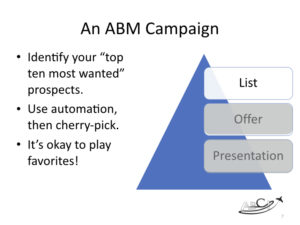 Paula Williams: All right, so let’s talk first about the list, right? What we want to do is identify our top 10 most wanted prospects. Now, this is not rocket science, but there is-
Paula Williams: All right, so let’s talk first about the list, right? What we want to do is identify our top 10 most wanted prospects. Now, this is not rocket science, but there is-
John Williams: But if you don’t have them, you should identify them before you ever get to here.
Paula Williams: Right. Exactly. How do we do that?
John Williams: I’m quite sure you’re going to explain it.
Paula Williams: Okay. There is some automation that you can use to narrow things down based on demographics, based on finances, based on company size, based on geography, based on aircraft type and all of those things. So some of the sources that you might use for things like that are some mailing list companies. List brokers will help you narrow this down. You can use your social media actually to identify and narrow down some of these things. Some of the backend tools in [crosstalk 00:09:40].
John Williams: Depending upon what you’re selling, you might use do in magazine.
Paula Williams: Right. Or-
John Williams: Private Pilot.
Paula Williams: Exactly. Look for people who are advertising in their-
John Williams: AOPA.
Paula Williams: Right? There’s lots of ways to identify the demographics of your ideal customer. So you put together the what are we looking for geographically, financially, aircraft type, and whatever other categories we want to put that in.
Use Technology First, Then Human Analysis to Pick Your List.
Paula Williams: We use whatever tools we can. We use JETNET, AIRPAC, a lot of the social media backend tools and things like that to identify people. That will give you a list. But then what you want to do is go through that list as a human being.
John Williams: Exactly.
Paula Williams: Right? And cherry pick the ones that you really want to have as customers. Because aviation is a small world and you know that there are some people that you would rather work with than others, right?
John Williams: Use automation, it’ll come up with a list of hundreds, and you want to narrow that down to the top 10.
Paula Williams: Top 10. Exactly. If you can narrow it down as far as you can using the automated tools, and then pick the people that you really, really want to work with. That might be because of name recognition. You’d love to have them as a reference client. Maybe people that you have heard are really great to work with, people that you’ve always dreamed of having as a client, those kinds of things. Because that’s more motivating for you anyway, if they’re people that you really want to work with.
John Williams: As soon as you sell one, or two, or three, then you go pick one, or two, or three back from that original list. Or run the automation again and reselect.
Paula Williams: Exactly. That’s how you pick your list. It is okay to play favorites, right? You don’t have to take what the machine gives you, because machines aren’t that smart yet. They can tell you what’s in the demographics and everything else, but there might be some that fall just outside that range that you’ll want to look at for different reasons.
John Williams: And then that’s why you’re smarter than a machine.
Paula Williams: Right. This is the really cool thing about using really small numbers, is that you can spend some time doing this and looking through it by hand, right?
John Williams: Absolutely.
Paula Williams: All right. Okay, so that’s your list. You now have your top 10. We’re ready to move on. Right? If not, press pause.
John Williams: And go back and redo.
Paula Williams: Get a pencil, get your top 10 list. You may know these off the top of your head. If you’ve been working in this industry for a long time, you know who the players are. If you’re brand new, you might want to use some of those automated tools and things like that to help you out. But get your top 10 before you proceed, and then we’ll carry on.
John Williams: If you don’t know how to do any of that, call us and we’ll help.
Paula Williams: Exactly. We do this a lot in people’s office hours.
John Williams: Uh-huh (affirmative).
Second Element of an ABM Campaign – The Offer
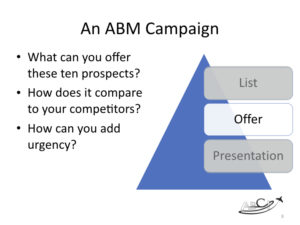 Paula Williams: Okay. The offer. What can you offer these 10 prospects? Now that you’ve got a list of 10, you will notice some common things about them. You’ll notice they have some pretty common problems, pretty common frustrations. What is it about these 10 people that you can really help with, better than any of your competitors? And so on. That’s the next thing is you want to compare it with what other things are on the market and why should they choose you rather than them.
Paula Williams: Okay. The offer. What can you offer these 10 prospects? Now that you’ve got a list of 10, you will notice some common things about them. You’ll notice they have some pretty common problems, pretty common frustrations. What is it about these 10 people that you can really help with, better than any of your competitors? And so on. That’s the next thing is you want to compare it with what other things are on the market and why should they choose you rather than them.
John Williams: Which is what you have to tell them.
Paula Williams: Exactly. You want to get this really solid in your head before you pick up the phone, right?
John Williams: Yeah.
Paula Williams: Because they’re going to ask you, “How does this compare to X, Y, or Z?” And you’re going to want to have a really good answer. Not to bash the competition, because aviation is a small world and we don’t want to throw any stones in glass houses.
John Williams: Nope.
Paula Williams: But we do want to know why our product is better than the competitor’s. And then the third thing is how can you add urgency? Because even if they think it’s a great idea, even if they agree, “Okay, this is wonderful. Let’s talk about this next year when I feel like I have time to think about it.” If you can find some way to add urgency either because of an FAA requirement, or a deadline, or a tax thing, or something that’s going on, that’s going to be an advantage for them to move forward quickly.
John Williams: If you’re installing ADS-B right now in airplanes, and you have some availability, you should be able to sell it pretty easily.
Paula Williams: Yeah, some built-in urgency.
John Williams: Right.
Paula Williams: Right. If not, you might need to manufacture some urgency or look for some other reasons for urgency. Maybe you’ve got some folks with some downtime right now, so you can give people a little bit of a scheduling priority or throw in an incentive to get started sooner rather than later.
John Williams: Yeah, it happens to everybody, including us. Sometimes we have, not a downtime, but a time when all of a sudden we’re going 90 to nothing, and we slowed down to 80, and you said, “Wait a minute, we can do something else.”
Paula Williams: Right. We’ve got all of these web developers, and graphic artists, and people who are already revved up working on something. And then that project ends, and then suddenly we’re like, “We need something for these guys to do so that they don’t-
John Williams: We plan not to let them in without something else to do, but on occasion.
Paula Williams: Mm-hmm (affirmative). They get finished early or something happens, the project gets canceled. It happens.
John Williams: Or even it wasn’t as difficult as we expected.
Third Element of an ABM Campaign – the Presentation
 Paula Williams: Right. That’s true. That’s the offer. We did the list, we got our top 10, we figured out what to offer them, and now we’re moving on to the presentation, right?
Paula Williams: Right. That’s true. That’s the offer. We did the list, we got our top 10, we figured out what to offer them, and now we’re moving on to the presentation, right?
John Williams: Mm-hmm (affirmative).
Paula Williams: Okay. This is where most people think that marketing starts, but actually marketing started three steps ago, right?
John Williams: Yeah.
Paula Williams: Okay. We like to start with something like a very personalized letter. I know this about your company and I really admire this about your company. Here are some things that you should know based on what we know about you, and here’s how we would like to maybe begin a conversation about whether this could be of value to you.
John Williams: Besides, the fact that you took the time to research their company will get their attention at least.
Paula Williams: Yeah. This is not the robocall, right?
John Williams: Right.
Paula Williams: This is the total opposite of that. You want to show some definite homework here, so that you’re not wasting their time.
Paula Williams: We like to use a direct mail package that’s going to stand out in their mail. We like three-dimensional objects that are sent in a box rather than a letter. This helps get past the gatekeeper. We’ve talked about this before. A lot of people will leave instructions with their admin staff and things like that. Discard anything that looks like an advertisement, but send me all packages or all personal letters and things like that. So you want this to look like a package and/or a personal letter.
Paula Williams: Packages are super easy to do. Even if you send candy, or a toy airplane, or anything that’s going to get their attention and stand out in their mail.
John Williams: If after some amount of time they still haven’t and you’re really into it… We have a gentleman that told us the story that after, I don’t know, some number of months, they still hadn’t responded, he boxed up a trashcan-
Paula Williams: Right?
John Williams: … and sent it to them.
Paula Williams: Had it delivered by courier, actually. A galvanized, shiny silver trashcan, right?
John Williams: He said, “Here, this is so you can put all of our mail into it, which I’ve sent to you if you ever-
Paula Williams: That you’ve been throwing-
John Williams: And they responded to him.
Paula Williams: Yeah, they did. Actually, he ended up getting an appointment and getting the work because he was so persistent and so creative and things. So you may want to go to that extent. But if you can start with something clever, or something cool, or even something that just stands out in their email is really the main thing. Thing number one is to get it opened. Thing number two is to get it read so that they know that this is something you’ve done some homework on. Right.
John Williams: Right.
ABM Marketing Activities – Events!
 Paula Williams: Okay. Events are a wonderful thing for these top 10 type folks. Invite them to a breakfast that you’re having at a convention, or go see them.
Paula Williams: Okay. Events are a wonderful thing for these top 10 type folks. Invite them to a breakfast that you’re having at a convention, or go see them.
John Williams: Even at a convention, we do that.
Paula Williams: Yeah, we do that with-
John Williams: At NBAA every… It’s different in every place, where we do it and how, but we do it.
Paula Williams: Exactly. Those events, especially if you’re spending over $10,000 on an annual contract or something like that. For that kind of money, people want to see you in person, and shake your hand, and look you in the eye, right? So events are a really great way to do that, either with existing conventions and things, or by making a special trip out there. Right. Get your butt on a plane. That’s what aviation is all about.
John Williams: Yeah. Or when we go to NBAA, like last time in Florida, I think we should do that every year.
Paula Williams: Mm-hmm (affirmative). Absolutely. We did in-person visits to prospects and current clients. We made a road trip out of it, which was actually a lot of fun.
John Williams: Yeah, we were just going to do a road trip just for the heck of it. Instead, she said, “We’re going right by…” So then we modified it and hit all of the clients on the East Coast.
Paula Williams: Mm-hmm (affirmative). Absolutely. Some of them have been clients for years and we’ve never met. So that’s an exception to the rule. But for the most part, I think we sell a lot more when we’ve actually shaken somebody’s hand and been in the same room with somebody.
Paula Williams: Phone calls. This is where the phone call comes in handy. We’ve got a sales call checklist that you want to make sure that you’re super prepared for that call, and this is not going to be a waste of that person’s time, to pick up the phone and talk to you. Right?
John Williams: Right.
Paula Williams: Okay. So not the robocalls, but the very customized calls.
Paula Williams: Client appreciation events. This is a thing that we have a whole article about on our website, where we talk about once a year, a lot of our clients will throw a customer appreciation event where they invite all of their current customers. And then they will invite… Where they shoot for a mix. I think we figured out the ideal mix is about 75% happy customers versus 25% prospects. So then you have prospects surrounded by happy customers, people that they can ask questions of, people who are going to be talking about you of course, since that’s what they have in common at this event. So if you can get everybody together for a barbecue or any kind of a customer-
John Williams: Breakfast.
Paula Williams: Yeah, a breakfast. A hundred dollar hamburger or whatever it is that you do, make sure that that is something where you can invite the right ratio of people, and maybe do that once a year.
John Williams: Mm-hmm (affirmative).
Paula Williams: Okay. That’s another fantastic addition to a top 10 or ABM campaign, right?
John Williams: Yes.
An Example ABM Campaign
Paula Williams: Okay. Here’s an example of an ABM for aviation marketing campaign. This person… We set this up for someone. This is the outline that they are following. Week one, they send a direct mail package. This particular one had a balsa wood toy airplane, right? With a personalized letter and everything else. So didn’t spend a ton of money, but spent some time and thought to put these together and make them into a nice package. They sent them in these Priority Mail small boxes per USPS. So you can do whatever you like, but as long as it stands out from their regular run of the mill advertisements in the mail.
John Williams: And you need to realize if you don’t already, that customer acquisition costs money.
Paula Williams: Yeah. The nice thing about ABM or a top 10 list is you can spend $10 per name on that list, and only spend $100. You could spend $100 on every name on that list and only spend $1,000, which is really not a ton of money in the vast scheme of your marketing budget, right?
John Williams: Right. It shouldn’t be anyway.
Paula Williams: Exactly. So keeping the numbers small will help you make this super personalized and a lot more classy on the front-end, right?
Paula Williams: Week one, direct mail package. Week two, a personal phone call. This was just basically, “Did you get my package? Are there any questions that we can answer for you?” And, “By the way, we’re having a breakfast that we’d like to invite you to.” That’s basically not a salesy call, it’s just an introduction. Those kinds of things give you an excuse to make that phone call without it being an immediate sales pitch.
John Williams: Yes.
Paula Williams: Okay. Week three, breakfast. Right? I think this actually did have a little bit more time between week two and week three, but we’re condensing for the purpose of the podcast, right?
John Williams: Uh-huh (affirmative).
Paula Williams: Okay. You have breakfast with them and you send a thank you note. And then over breakfast, you are basically presenting your material and you’re presenting your offer.
John Williams: These are guidelines. I mean, timing, week one, week two, it could be two or three weeks in between. It just depends on how the flow goes. You need to figure out what that is and go with it.
Paula Williams: Right. You could do four weeks, you could do 12 weeks, whatever makes sense for your cadence of sales, and how many people you have working with you, and what resources you have, and everything else. Okay. And then send a personal thank you note after the breakfast, usually the day of or the day after you’d send that note.
Paula Williams: And then week four, do a follow up appointment. I know you probably have more questions than answers at this point. Let’s follow up and do a more personalized meeting where we can really do some discovery on what you really need, and get down to solutions.
John Williams: Yeah, because at breakfast, you will have had discussions as they will have, and you will probably have already said, “We need to get together again.” So they’re just doing a follow up on that.
Paula Williams: To schedule that. Exactly. All of that is fairly neatly laid out. Adapt this, steal it, do whatever you like with this plan. Like I said, you can do it in four weeks, you can do it in 12, whatever you think is appropriate. But you want to think in terms of super personalized, super classy, non-pushy, and all of those things.
Three Possible Responses to an ABM Approach
Paula Williams: As a result of this campaign, at any point during this 4 to 12 week process, you’re going to hear one of three responses, right?
John Williams: And they’re all okay.
Paula Williams: And they’re all okay. Any response is a good response.
John Williams: Of course.
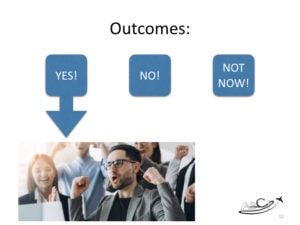 Paula Williams: Right. Because your ultimate purpose is to discover if this is a good customer for you or not, and carry on from there. If the answer is yes, woo-hoo, right?
Paula Williams: Right. Because your ultimate purpose is to discover if this is a good customer for you or not, and carry on from there. If the answer is yes, woo-hoo, right?
John Williams: Make a sale.
Paula Williams: Make a sale, and carry on doing fantastic customer service and all of those things. You don’t just drop this person, you make sure there’s a good handoff, right?
John Williams: No. Yeah.
Paula Williams: You don’t just celebrate and then drop them. Never talk to them again.
John Williams: Nope.
Paula Williams: Okay.
John Williams: No, that would be bad.
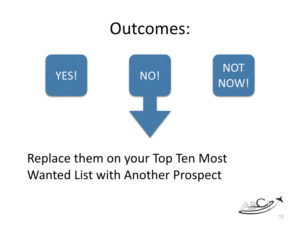 Paula Williams: Yeah. Okay. A yes, obviously you made a sale. Congratulations. That’s a wonderful thing.
Paula Williams: Yeah. Okay. A yes, obviously you made a sale. Congratulations. That’s a wonderful thing.
What if the Customer Says No?
A no is a perfectly fine response as well. You replaced that person on your top 10 list with another prospect. So you go back to whatever source you got your names from.
John Williams: And then you don’t waste any more time on them.
Paula Williams: Exactly. They come off your list. If they’re absolutely not ever going to be interested for whatever reason, then they come off your list.
What if they like the idea but they’re not ready to buy now?
If it is not a no necessarily but a not now, that’s fine too. You just put them into your holding pattern.
John Williams: Everybody in aviation, that’s what a holding pattern is.
Paula Williams: Yeah, right. That’s when you want to land, but usually when you have to go to the bathroom and you want to land. And ATC has other plans for you, and says you have to get behind all these other people, so go cool your heels in a holding pattern. Right?
John Williams: Yeah, you’re showing your place though because most jets have a thing in the back that you can go use.
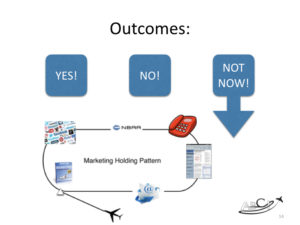 Paula Williams: That’s true. But anyway, you may-
Paula Williams: That’s true. But anyway, you may-
John Williams: The smaller airplanes, you’re right.
Paula Williams: Exactly. Being a small plane pilot, you adapt.
John Williams: Yeah, even the single pilot, like all the way up to the CJ4, your single pilots, you still have the same issue.
Paula Williams: Exactly. You get put into a holding pattern. We have a holding pattern in marketing as well. Basically, what that means is that person will be interested at some point in the future, so you keep-
John Williams: Which is why they say, “Not now.”
Paula Williams: Exactly. So you keep sending them birthday cards and sending them newsletters. Maybe when you have an event or something, you invite them. Other things like that because you know at some point in the future, it might be 10 years from now, they will become a customer.
John Williams: Mm-hmm (affirmative).
Paula Williams: Okay. So ‘not now’ is a perfectly fine response as well. This really takes the fear out of the whole sales process.
John Williams: It should.
Paula Williams: Yeah, because at the end of four weeks, you’re going to have one of three responses. Yes, no, or not now. Any of those responses is a good one.
John Williams: Absolutely.
Paula Williams: Right, because you’ve worked through that prospect, you’ve gotten them processed through your list, you’ve made a friend, hopefully. Or at least someone now knows about your products and services that didn’t before, that might be a good referral source.
John Williams: It even works when you’re asking somebody out for coffee.
Paula Williams: I know. Was I in a holding pattern? Is that what it was? Was it ‘not now’?
John Williams: Evidently.
Paula Williams: All right. Okay. Yeah, we had a really long sales cycle when John first asked me out. There was a really long sale cycle involved for a lot of reasons, but that was… Not the least of which is that we worked for competing companies. But anyway.
John Williams: At the same client.
Paula Williams: At the same client. So that was not awkward at all. But yeah, that went into a holding pattern. We eventually went out for coffee, but it took a long time.
John Williams: Yes, it did.
Rinse, Improve and Repeat your ABM Campaign
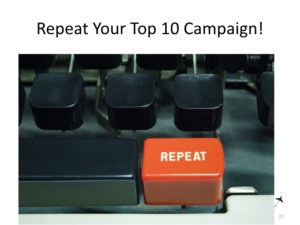 Paula Williams: Okay. So to continue or scale ABM for aviation marketing, you simply repeat your top 10 campaign. Take the next 4 to 12 weeks, run it over again. As you do this, you’re going to find out, “This worked really well. This balsa wood airplane, it’s easy to stick in a box. There’s reasonable ways to get hold of them. We found a new supplier for them. It all works.” All of that stuff is pretty cool. So that’s a wonderful thing.
Paula Williams: Okay. So to continue or scale ABM for aviation marketing, you simply repeat your top 10 campaign. Take the next 4 to 12 weeks, run it over again. As you do this, you’re going to find out, “This worked really well. This balsa wood airplane, it’s easy to stick in a box. There’s reasonable ways to get hold of them. We found a new supplier for them. It all works.” All of that stuff is pretty cool. So that’s a wonderful thing.
Paula Williams: You may find parts of this process that don’t work so well. Maybe when you make that phone call, that is not your thing. You’re not really able to do that all that well. You stumble and bumble in phone calls, so you send an email instead. There’s lots of ways that you can improve this process. You just want to make sure that all the steps are there.
John Williams: Actually, even if you stumble through the thing, you’ll do the next one better.
Paula Williams: You will get better, I promise. Any-
John Williams: You promise?
Paula Williams: Yeah. Sometimes it’s a matter of making yourself do the thing that you hate the most, and then it becomes the thing that you like the most. That was my problem with short-field landings. Hated short-field landings. Could not get that to work no matter what I did.
John Williams: Over a 50 foot obstacle.
Paula Williams: Yeah, the 50… Yeah, exactly. The 50 foot obstacle, the short-field landing, had the hardest time with that. But then it became my favorite thing to do once I figured it out.
Paula Williams: That happens as well with sales skills and sales tasks. Once you get good at something, you start to look forward to it and you start to realize, “Wow, I don’t suck. I can actually do that.” By following an outline, or getting some help, or getting some coaching, you can usually get over that obstacle. There you go. Pun intended. And get much better at that particular skill.
John Williams: Mm-hmm (affirmative).
ABM for Aviation Marketing in a Nutshell – Long-Cycle, Small-List Campaigns.
Paula Williams: All right. That is ABM in a nutshell. That is how it works for aviation, and that’s how we’ve been making it work for clients for a million years before it was called ABM.
John Williams: True.
Paula Williams: Right? Okay.
John Williams: Not about a million years, but for quite a while.
Paula Williams: Right. Okay. Never exaggerate. I told you a million times never to exaggerate.
John Williams: Exactly.
Paula Williams: Okay. We have been… Basically, ever since we started, we were focusing on long cycle, small list campaigns. That’s not exaggerating.
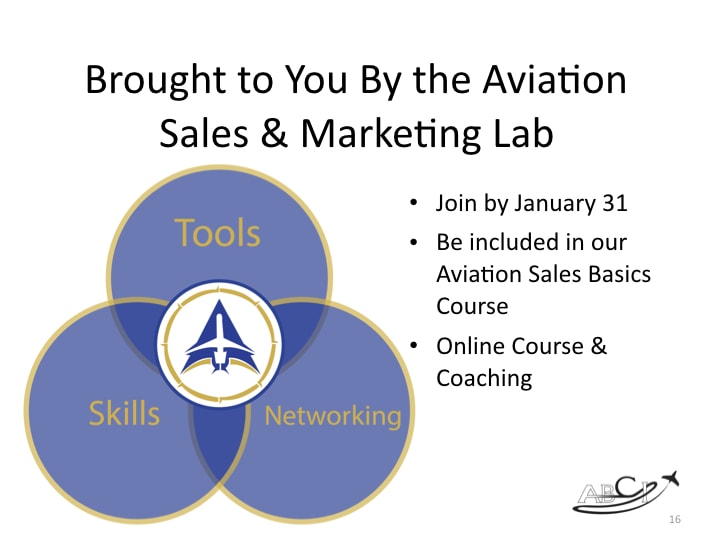 Paula Williams: But if you are interested in getting better at sales, getting better at marketing, we have a group of people that is in the same boat, and we’re all working on learning new technologies, new skills, new tools, new networking opportunities and things like that. We’d love to have you join us. If you join us by January 31st, then you’ll be included in our Aviation Sales Basics course, which is a 12 unit course. Usually takes people 12 weeks to complete. It includes a lot of interaction with us as well. That’s a lot of fun to do. I promise at the end of 12 weeks you will be a much better salesperson. You can’t help but improve.
Paula Williams: But if you are interested in getting better at sales, getting better at marketing, we have a group of people that is in the same boat, and we’re all working on learning new technologies, new skills, new tools, new networking opportunities and things like that. We’d love to have you join us. If you join us by January 31st, then you’ll be included in our Aviation Sales Basics course, which is a 12 unit course. Usually takes people 12 weeks to complete. It includes a lot of interaction with us as well. That’s a lot of fun to do. I promise at the end of 12 weeks you will be a much better salesperson. You can’t help but improve.
John Williams: Right.
Paula Williams: Right? Okay. It also includes our online course and coaching. It doesn’t matter where you are, it doesn’t matter what time zone you’re in, it doesn’t matter any of that stuff. We’ll make it work for you. Right?
John Williams: A very famous sales guy…
Paula Williams: Go sell more stuff.
John Williams: And America needs the business, which is true. But he also said, “If you’re determined to learn, nobody can stop you.”
Paula Williams: Mm-hmm (affirmative). Exactly. If you are determined not to learn, nobody can help you. But if you are determined to learn, then nobody can stop you. Those are the kinds of folks that we have in our group, which makes it so much more fun. Right?
John Williams: Yeah. And America does need the business. Thank you, and we will see you next time.
Paula Williams: Absolutely.
Podcast: Play in new window | Download
Subscribe: Spotify | Amazon Music | RSS

